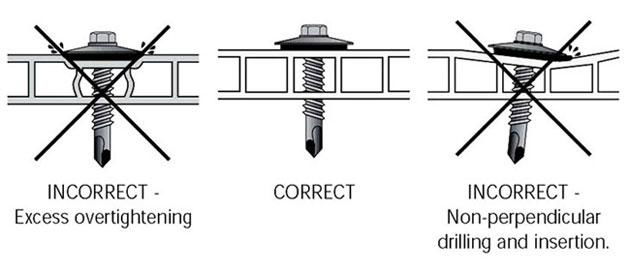
Installation Method
Fasteners, Washers and Spacers
Use a screw that is appropriate for the thickness of the panel being applied All screws should feature a corrosion resistant
long-life coating to ensure durability. Stainless steel fasteners are recommended in extremely corrosive environments.
8mm panels should be directly point fastened at each purlin location using #10 x 2” wood grip screw or #12 x 1 1⁄2” self-drilling tapping screw with a 1”(25.4 mm) Umbrella Washer. 1” Thermal Glass Spacer Washers should be used under the panel at every point fastener to keep panel elevated at the same height as the support rafter, bottom channel, or ridge, and to help reduce condensation drip at purlins.

Pre-Drilling
A hole must be pre-drilled into each screw location.The diameter of that hole should be 2mm or
1/16” (2mm) larger than that of the screw, to allow forthermal expansion movements. Special attention
should be given to drill all the required holesperpendicular to the face of the material
Over Tightening
An electric screwdriver withan adjustable clutch shouldbe used to tighten screws.It is imperative that over
tightening be avoided in orderto avoid undue stresses, which would cause premature failure and buckling of the sheet.
Be certain to insert the screws perpendicular to the material face, as inclined insertion could damage the sheet and/or result in leaks
Fastener Spacing
At intermediate purlins:
The sheets have to be fastened to the purlins by fastening screws, inserted along the supporting purlins, spaced about 24” (600 mm) apart,and 12” (30 mm) from the Support Rafter and Snap-Cap.
At panel ends:
If panel ends are inserted into glazing profiles with channel recesses designed to accomodate polycarbonate (at ridge, gutter
or eave), fasteners are optional, but are highly recommendedwhen wind or snow loads can be excessive. If fasteners are used at
these points, placement should be the same as at intermediate purlins.
When panel end over hangs eave:Along the edge purlin (or gutter) where the panel is not inserted into a channel recess, the
fastening screws should be spaced about 12” (300 mm) apart apart. Permeable Tape and a Protective U-Channel
should be used for this type application.
Note: Panel ends should not over hang the eave by more than 3” (76mm). Along vertical edges of panel:
Fasteners are not necessary along the vertical edges of the panel. Securing the vertical edges of the panels is
achieved with Support Rafter and “SnapCap”, Tonon “H” Profiles, or other similar glazing system components.
Arch Radius Construction
Nature's panel is sufficiently flexible to allow vertically positioned panels to conform
to arched construction. However, when installing 8mm hollow pc sheet, it is not
recommended that panels be affixed to curved surfaces where the curve radius is less
than 55 inches. Affixing the panel to tighter radii surfaces may result in local stress
crazing and deterioration over time.
Sealing and Bonding
Sealants
Only compatible silicone sealants should be used with Nature's panels if required.
Silicone sealants are not typically needed when installing ThermaGlas panels.
However, if there is a need to seal odd cuts or gaps approved silicone sealants can be
used to seal these gaps.
Sealing is recommended with Nature PC H conecter and Tonon Specials profile.Place a bead of sealant between the inserted panel
and the profile.This will prevent moisture and dirt to accumulate between the profile and panel.
IMPORTANT NOTE: Many typical greenhouse shading compounds are aggressive
to polycarbonate.
WARNING: Shading materials containing vinyl binders or organic
solvents are aggressive to Nature's panel and should be avoided.
Contact the manufacturer of the shade compound you wish to use and gain their
Cleaning and Care
General Cleaning
Cleaning of Tnon panels is important to yield long-term results and maintain
sufficient light transmission of panels. Self-cleaning by rain is usually sufficient. If
required, use diluted mild household detergents for additional cleaning. Make sure
the detergent contains no abrasives or solvents. Pre-wash with warm water, then wash
area to be cleaned with a soft sponge or brush, preferably with hot water, until clean.
Rinse with water and dry with a soft non abrasive cloth.
Heavy Oils or Tar Stains
Heavy oil or tar stains can be removed with an ethyl alcohol watery solution. Rub
the area gently with a soft rag. Follow with general cleaning as stated above, rinsing
thoroughly with water before drying.
Cleaning Large Areas
Large areas may be professionally washed with a high-pressure water jet, possibly
adding a mild compatible detergent, and/or stream jet. Avoid allowing the spray tip to
come too close to the panel. Pressure washers often have enough pressure at the spray
tip to penetrate or tear the panel.
Avoid
Avoid cleaning the panel when dry, as the sand and dust particles cling to the exterior
of the panel and may scratch the surface (minor surface scratches will not damage the
panel, the scratches will simply reduce optical clarity).
Avoid repeated sliding of sheets over each other, even when protected by the
protective film. This action generates an electrostatic charge in the sheet, attracting
dirt and dust and hindering cleaning.
See section in this booklet titled “Chemical Compatibility” for other important
information.
Storage and Handling
Storage and transportation of the sun panels
(1) To be saved in the indoor never allow direct sunlight or rain
(2) Hand stacking, stacking height of not more than two meters. Board shall ballast, no hard object between the plates.
(3) The storage room should be kept clean, dry and to avoid dust intrusion. Indoor storage of other chemicals should not also.
(4) Storage shall not be damaged or torn off protective film.
(5) Transportation must be flat on a clean flat tray area is larger than the plate, if necessary, should be properly tied to avoid vibration and sliding pay attention to protecting the plate side is not so damaged and a double-sided protective film intact.
Panels can be stored outdoors without suffering damage from rain or snow. However,
panels must not be exposed to direct sunlight while they are stacked. Stacks of three
or more panels act as a solar heat collector and may incur heat stress damage, which
is not covered by the warranty. The original white, watertight polyethylene package is
sufficient to protect panels from this type of damage (do not confuse the packaging
film mentioned here with protective masking film that is electrostatically adhered to each sheet). Do not stack heavy objects on the panels.
Avoid leaving the sheets in the rain, even if still wrapped,for extended periods, as water may condense inside thehollow core.When necessary to store panels in the open, cover them with a white opaque,polyethylene sheet, cardboard, or any insulating material, taking care to cover the pallet completely.
Nature panels should be transported and stored horizontally, on a flat, sturdy
pallet whose dimensions are equal to or larger than the sheets themselves. The sheets
must be secured and fastened to the pallet during transportation and handling at the
site. It is possible to stack the sheets with the longer sheets at the bottom and the
shorter on top, leaving no unsupported overhang.
While moving a pallet with a forklift, use fork extenders if necessary so the the full
width of the sheet is lifted. Using shorter forks on a wider pallet may cause damage to the sheets.
Saw It is very easy to cut PC sheet accurately with standard tools in the workshop.these tools include circular saw, manual saw and steel saw.The sawdust in the sheet channel can be blowed by clear and compressed air.The circular saw should be equipted with fine serrated blade.When eletrical saw or manual saw is used,it should be clamped on the table to avoid Vibration.It should be without notch or saw dust after sawing.As to thin sheets,you can cut with sharp reamer directly.
Drill
Drill You can drill holes by manual drill or power drill.There should be holder under the drill to avoid Sloshing during work.


